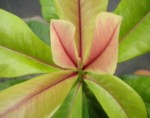Scientific Name: Myrsine lessertiana
Also Known As: Kolea lau nui
Endemic: All of HI except Ni’ihau and Kaho’olawe
Description: Stunning trees or large shrubs reaching heights of up to 25 ft. tall. They have extremely glossy, light green leaves that when they are young (liko) are colored brilliantly pink. This is one of the most beautiful sites to see in the wild (or in the landscape) when all of the branch tip buds are starting to show new signs of growth and the tree is covered in pink. The flowers are small, green with purple tinges and emerge from woody knobs along the branches. Once the flowers are pollinated they develop into tiny black fruit about ¼” across.
Distribution: This endemic tree is normally found in mesic to wet forest and sometimes in subalpine shrubland from 600ft. to over 6000ft. in elevation on all of the main Hawaiian Islands except Ni’ihau and Kaho’olawe.
Cultural Uses: The strong wood of kolea is used for posts and beams in the construction of hale as well as to make the anvil for beating kapa, while the red sap of the plant is used to make a red dye and the wood charcoal a black dye.
Landscape Uses and Care: These trees deserve to be grown more and incorporated into more landscapes. Their beauty alone is enough reason but also to help preserve the plant from becoming increasingly rare. Water daily to help establish the plant easier, then reduce watering to about 2 times a week once signs of active growth begin to show. Few pests bother kolea lau nui but be careful when transplanting because it doesn’t like it when its roots are bothered too much. Right now this plant is available at Hui Ku Maoli Ola native plant nursery in 3 gallon pots for $45.
Extra Info: Studies have shown that early Hawaiian settlements in Waimanalo, O’ahu which date back close to 450 A.D. have fire pits with the charcoal of kolea lau nui within them. This shows that the plant grew much lower in elevation back then, then it does today. I don’t think a Hawaiian person would walk up to 600 ft. elevation in Waimanalo (which would be half way up the pali face) just for fire wood or carry down large logs of kolea lau nui to the ocean to burn it to make dye. The only other reasonable explanation would be that it grew close enough to gather dry wood to make a fire which would put it way closer to sea level than current populations today.
Kolea








